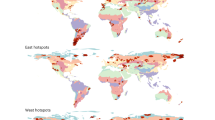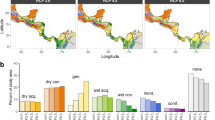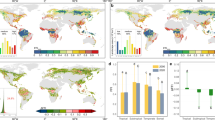Abstract
Range shifts are a crucial mechanism enabling species to avoid extinction under climate change1,2. The majority of terrestrial biodiversity is concentrated in the tropics3, including species considered most vulnerable to climate warming4, but extensive and ongoing deforestation of tropical forests is likely to impede range shifts5,6. We conduct a global assessment of the potential for tropical species to reach analogous future climates—‘climate connectivity’—and empirically test how this has changed in response to deforestation between 2000 and 2012. We find that over 62% of tropical forest area (~10 million km2) is already incapable of facilitating range shifts to analogous future climates. In just 12 years, continued deforestation has caused a loss of climate connectivity for over 27% of surviving tropical forest, with accelerating declines in connectivity as forest loss increased. On average, if species’ ranges shift as far down climate gradients as permitted by existing forest connectivity, by 2070 they would still experience 0.77 °C of warming under the least severe climate warming scenario and up to 2.6 °C warming for the most severe scenario. Limiting further forest loss and focusing the global restoration agenda towards creating climate corridors are global priorities for improving resilience of tropical forest biotas under climate change.
This is a preview of subscription content, access via your institution
Access options
Access Nature and 54 other Nature Portfolio journals
Get Nature+, our best-value online-access subscription
$29.99 / 30 days
cancel any time
Subscribe to this journal
Receive 12 print issues and online access
$209.00 per year
only $17.42 per issue
Buy this article
- Purchase on Springer Link
- Instant access to full article PDF
Prices may be subject to local taxes which are calculated during checkout



Similar content being viewed by others
Data availability
Pan-tropical climate connectivity data that support the findings of this study are available on Figshare (DOI: 10.15131/shef.data.8340578).
Code availability
Custom Python code to calculate climate connectivity will be available on GitHub (https://github.com/rasenior/ClimateConnectivity). These scripts have been directly adapted from the methods in McGuire et al.6 and the R code therein (https://github.com/JennyMcGuire/ClimateConnectivity).
Change history
12 August 2019
An amendment to this paper has been published and can be accessed via a link at the top of the paper.
References
Chen, I.-C., Hill, J. K., Ohlemüller, R., Roy, D. B. & Thomas, C. D. Rapid range shifts of species associated with high levels of climate warming. Science 333, 1024–1026 (2011).
Parmesan, C. Ecological and evolutionary responses to recent climate change. Annu. Rev. Ecol., Evol., Syst. 37, 637–669 (2006).
Jenkins, C. N., Pimm, S. L. & Joppa, L. N. Global patterns of terrestrial vertebrate diversity and conservation. Proc. Natl Acad. Sci. USA 110, E2602–E2610 (2013).
Sunday, J. M. et al. Thermal-safety margins and the necessity of thermoregulatory behavior across latitude and elevation. Proc. Natl Acad. Sci. USA 111, 5610–5615 (2014).
Taubert, F. et al. Global patterns of tropical forest fragmentation. Nature 554, 519–522 (2018).
McGuire, J. L., Lawler, J. J., McRae, B. H. & Theobald, D. M. Achieving climate connectivity in a fragmented landscape. Proc. Natl Acad. Sci. USA 113, 7195–7200 (2016).
Tucker, M. A. et al. Moving in the Anthropocene: global reductions in terrestrial mammalian movements. Science 359, 466–469 (2018).
Lewis, S. L., Edwards, D. P. & Galbraith, D. Increasing human dominance of tropical forests. Science 349, 827–832 (2015).
Mora, C. et al. The projected timing of climate departure from recent variability. Nature 502, 183–187 (2013).
Opdam, P. & Wascher, D. Climate change meets habitat fragmentation: linking landscape and biogeographical scale levels in research and conservation. Biol. Conserv. 117, 285–297 (2004).
Loarie, S. R. et al. The velocity of climate change. Nature 462, 1052–1055 (2009).
Littlefield, C. E., McRae, B. H., Michalak, J. L., Lawler, J. J. & Carroll, C. Connecting today’s climates to future climate analogs to facilitate movement of species under climate change. Conserv. Biol. 31, 1397–1408 (2017).
Nuñez, T. A. et al. Connectivity planning to address climate change. Conserv. Biol. 27, 407–416 (2013).
Lawler, J. J., Ruesch, A. S., Olden, J. D. & McRae, B. H. Projected climate-driven faunal movement routes. Ecol. Lett. 16, 1014–1022 (2013).
Hansen, M. C. et al. High-resolution global maps of 21st-century forest cover change. Science 342, 850–853 (2013).
Hijmans, R. J., Cameron, S. E., Parra, J. L., Jones, P. G. & Jarvis, A. Very high resolution interpolated climate surfaces for global land areas. Int. J. Climatol. 25, 1965–1978 (2005).
IPCC Climate Change 2013: The Physical Science Basis (eds Stocker, T. F. et al) (Cambridge Univ. Press, 2013).
Haddad, N. M. et al. Habitat fragmentation and its lasting impact on Earth’s ecosystems. Sci. Adv. 1, e1500052 (2015).
Green, R. E., Cornell, S. J., Scharlemann, J. P. W. & Balmford, A. Farming and the fate of wild nature. Science 307, 550–555 (2005).
Elsen, P. R., Monahan, W. B. & Merenlender, A. M. Global patterns of protection of elevational gradients in mountain ranges. Proc. Natl Acad. Sci. USA 115, 6004–6009 (2018).
Early, R. & Sax, D. F. Analysis of climate paths reveals potential limitations on species range shifts. Ecol. Lett. 14, 1125–1133 (2011).
Lees, A. C. & Peres, C. A. Conservation value of remnant riparian forest corridors of varying quality for Amazonian birds and mammals. Conserv. Biol. 22, 439–449 (2008).
Pacifici, M., Visconti, P. & Rondinini, C. A framework for the identification of hotspots of climate change risk for mammals. Glob. Change Biol. 24, 1626–1636 (2018).
Brito-Morales, I. et al. Climate velocity can inform conservation in a warming world. Trends Ecol. Evol. 33, 441–457 (2018).
Sunday, J. M., Bates, A. E. & Dulvy, N. K. Thermal tolerance and the global redistribution of animals. Nat. Clim. Change 2, 686–690 (2012).
Araújo, M. B. et al. Heat freezes niche evolution. Ecol. Lett. 16, 1206–1219 (2013).
Socolar, J. B., Epanchin, P. N., Beissinger, S. R. & Tingley, M. W. Phenological shifts conserve thermal niches in North American birds and reshape expectations for climate-driven range shifts. Proc. Natl Acad. Sci. USA 114, 12976–12981 (2017).
Schloss, C. A., Nuñez, T. A. & Lawler, J. J. Dispersal will limit ability of mammals to track climate change in the western hemisphere. Proc. Natl Acad. Sci. USA 109, 8606–8611 (2012).
Bonte, D. et al. Costs of dispersal. Biol. Rev. 87, 290–312 (2012).
Senior, R. A., Hill, J. K., Benedick, S. & Edwards, D. P. Tropical forests are thermally buffered despite intensive selective logging. Glob. Change Biol. 24, 1267–1278 (2018).
Sanford, T., Frumhoff, P. C., Luers, A. & Gulledge, J. The climate policy narrative for a dangerously warming world. Nat. Clim. Change 4, 164–166 (2014).
Corlett, R. T. Climate change in the tropics: The end of the world as we know it? Biol. Conserv. 151, 22–25 (2012).
ArcGIS Desktop: Release 10 (ESRI, 2011).
Freeman, B. G. & Class Freeman, A. M. Rapid upslope shifts in New Guinean birds illustrate strong distributional responses of tropical montane species to global warming. Proc. Natl Acad. Sci. USA 111, 4490–4494 (2014).
Raxworthy, C. J. et al. Extinction vulnerability of tropical montane endemism from warming and upslope displacement: a preliminary appraisal for the highest massif in Madagascar. Glob. Change Biol. 14, 1703–1720 (2008).
R Core Team. R: A Language and Environment for Statistical Computing (R Foundation for Statistical Computing, 2018).
Zuur, A. F. Mixed Effects Models and Extensions in Ecology with R (Springer, 2009).
Wood, S. N. Generalized Additive Models: An Introduction with R (CRC Press, 2017).
Bates, D., Mächler, M., Bolker, B. & Walker, S. Fitting linear mixed-effects models using lme4. J. Stat. Softw. 67, 1–48 (2015).
Aide, T. M. et al. Deforestation and reforestation of Latin America and the Caribbean (2001–2010). Biotropica 45, 262–271 (2013).
Acknowledgements
We thank J. L. McGuire for making code publicly available and for providing us with additional help and guidance. We are grateful to M. Pacifici for providing maps of climate vulnerability and BirdLife International for providing maps of Key Biodiversity Areas. We thank C. D. Thomas for her comments and suggestions in the revision of the manuscript. Thanks also to F. K. S. Lim, P. J. Platts and S. A. Scriven for helpful discussions. R.A.S. was funded by a NERC studentship through the ACCE (Adapting to the Challenges of a Changing Environment) Doctoral Training Partnership (Grant No. NE/L002450/1).
Author information
Authors and Affiliations
Contributions
R.A.S. and D.P.E conceived the study. R.A.S., D.P.E. and J.K.H developed the methods, with R.A.S. writing scripts to calculate climate connectivity and performing statistical analyses. R.A.S. wrote the first draft of the manuscript, with contributions from D.P.E. and J.K.H.
Corresponding author
Ethics declarations
Competing interests
The authors declare no competing interests.
Additional information
Peer review information: Nature Climate Change thanks Robert Colwell, Marlee Tucker and other, anonymous, reviewer(s) for their contribution to the peer review of this work
Publisher’s note: Springer Nature remains neutral with regard to jurisdictional claims in published maps and institutional affiliations.
Supplementary information
Supplementary Information
Supplementary Methods, Supplementary Figures 1–16, Supplementary Tables 1–6 and Supplementary References.
Rights and permissions
About this article
Cite this article
Senior, R.A., Hill, J.K. & Edwards, D.P. Global loss of climate connectivity in tropical forests. Nat. Clim. Chang. 9, 623–626 (2019). https://doi.org/10.1038/s41558-019-0529-2
Received:
Accepted:
Published:
Issue Date:
DOI: https://doi.org/10.1038/s41558-019-0529-2
This article is cited by
-
Struggling to keep pace
Nature Ecology & Evolution (2022)
-
Integrating land use and climate change models with stakeholder priorities to evaluate habitat connectivity change: a case study in southern Québec
Landscape Ecology (2022)
-
Prioritizing forestation based on biogeochemical and local biogeophysical impacts
Nature Climate Change (2021)
-
Climate change models predict decreases in the range of a microendemic freshwater fish in Honduras
Scientific Reports (2020)
-
Scenario-based estimation of catchment carbon storage: linking multi-objective land allocation with InVEST model in a mixed agriculture-forest landscape
Frontiers of Earth Science (2020)



